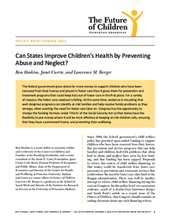This policy brief comes from the Future of Children journal - a collaboration of the Woodrow Wilson School of Public and International Affairs at Princeton University and the Brookings Institution in the United States. The brief outlines the current state of the Child Welfare System in the United States, particularly federal funding to individual states’ child welfare systems. According to the brief, the US federal government provides states more money for foster care and out-of-home placement services than for preventive services and programs that could keep children out of foster care. The brief highlights recent federal child welfare finance reforms, specifically the implementation of demonstration waivers, that allow states more flexibility in their child welfare programming, and which the brief urges states to take advantage of in order to reduce the numbers of children in foster care in the United States. “The prevention and treatment programs that have been shown to effectively promote child welfare, usually without removing children from their families, are expensive,” says the brief “though they can save money in the long run. Thus, most states argue that with more funding they could provide more, and more effective, programs and services.”

